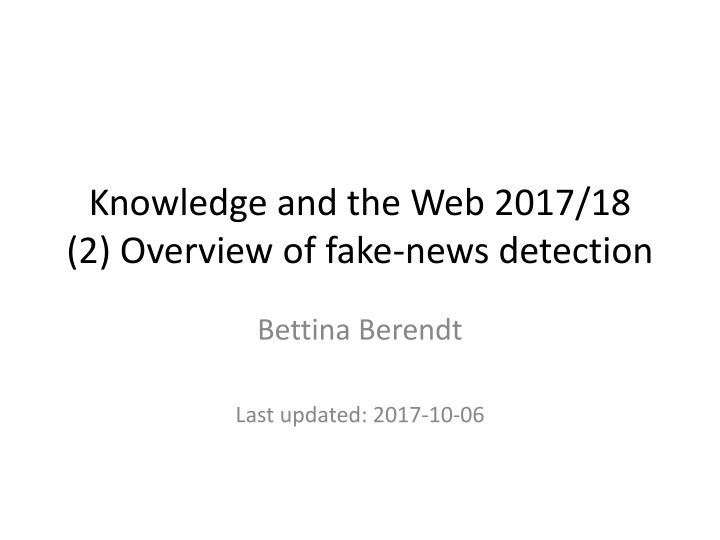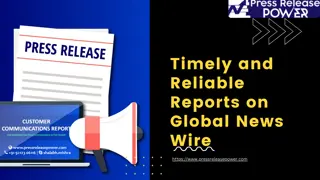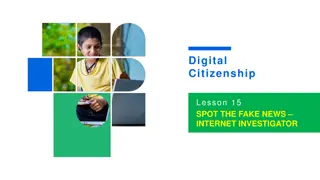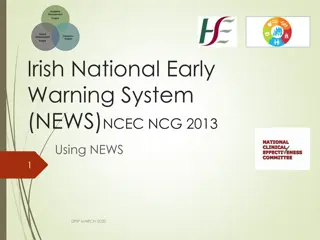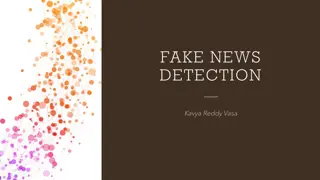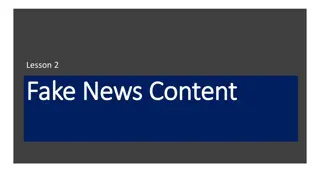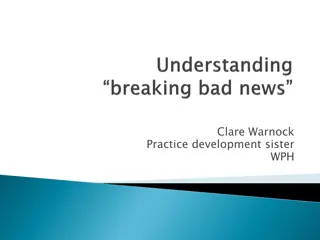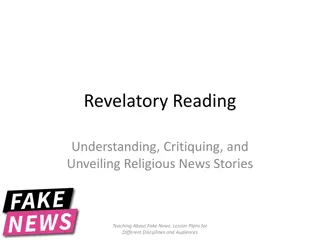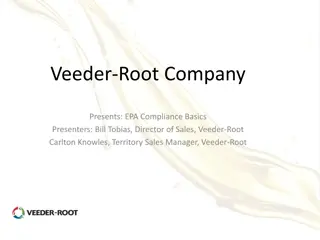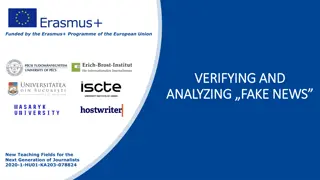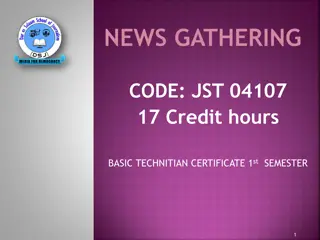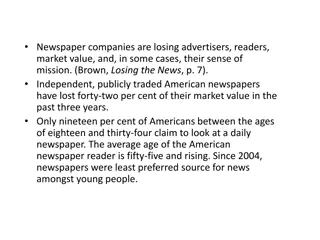Overview of Fake News Detection Methods in Knowledge and the Web
This content provides an overview of fake news detection methods in the context of Knowledge and the Web, covering topics such as the definition of fake news, business understanding, and the process of knowledge discovery. It discusses the implications of fake news dissemination and differentiates it from satire or opinion pieces. The course structure includes lectures on data mining processes and computational approaches to trust and reputation in web data mining. Overall, it emphasizes the importance of discerning misinformation from factual news in today's digital landscape.
Download Presentation

Please find below an Image/Link to download the presentation.
The content on the website is provided AS IS for your information and personal use only. It may not be sold, licensed, or shared on other websites without obtaining consent from the author.If you encounter any issues during the download, it is possible that the publisher has removed the file from their server.
You are allowed to download the files provided on this website for personal or commercial use, subject to the condition that they are used lawfully. All files are the property of their respective owners.
The content on the website is provided AS IS for your information and personal use only. It may not be sold, licensed, or shared on other websites without obtaining consent from the author.
E N D
Presentation Transcript
Knowledge and the Web 2017/18 (2) Overview of fake-news detection Bettina Berendt Last updated: 2017-10-06
Plan Lecture (Wed 16+) Exercise session (Thu 10.30+) Your individual & team work Overview, warm-up, Entry test Do the entry test Fake news detection methods: overview Establish team + research question for project (version 1) Semantic Web + Linked Data SPARQL Work on your project around the task of Fake news detection methods: research methods overview Methods continued and: DM / ML test Journalistic fact-checking (IT) Data quality task Trust and reputation: computational approaches (IT) Project consultancy Project consultancy SW/LD in industry (IT) Project consultancy LD Fragments (IT) Peer-reviewing of projects Ethics of web data mining: issues and approaches (incl. privacy, discrimination) Peer-reviewing of projects Peer-reviewing of projects Key IT = invited talk may be skipped by 4-ECTS students Project consultancy Project presentations
Structure for todays lecture: The process of knowledge discovery CRISP-DM CRoss Industry Standard Process for Data Mining a data mining process model that describes commonly used approaches that expert data miners use to tackle problems. http://www.crisp-dm.org/Images/187343_CRISPart.jpg
1. Business understanding What IS fake news?
Fake news a definition Fake news [ ] is where individuals or organisations intentionally publish hoaxes, propaganda and other misinformation and present it as factual. This can include blog and social media posts and fake online media releases. It does not include news satire sites such as The Onion or The Shovel as they are not presenting their content as legitimate factual news. Their intention is satire rather than misinformation. It also does not include articles that are written from the perspective of a particular opinion or editorial standpoint, provided the information included is factually correct. Slide from (Melbourne Atheneum Library, n.d.)
Fake news a definition Fake news [ ] is where individuals or organisations intentionally publish hoaxes, propaganda and other misinformation and present it as factual. This can include blog and social media posts and fake online media releases. It does not include news satire sites such as The Onion or The Shovel as they are not presenting their content as legitimate factual news. Their intention is satire rather than misinformation. It also does not include articles that are written from the perspective of a particular opinion or editorial standpoint, provided the information included is factually correct.
Fake news a definition Fake news [ ] is where individuals or organisations intentionally publish hoaxes, propaganda and other misinformation and present it as factual. This can include blog and social media posts and fake online media releases. It does not include news satire sites such as The Onion or The Shovel as they are not presenting their content as legitimate factual news. Their intention is satire rather than misinformation. It also does not include articles that are written from the perspective of a particular opinion or editorial standpoint, provided the information included is factually correct.
Actually, fake news was often used to denote precisely these news outlets before Trump made the term s current meaning popular
Weekend Update Beginning in 1975 with Chevy Chase, Weekend Update quickly became a favorite skit among all of Saturday Night Live s infamous sketches. Good night, and have a pleasant tomorrow. -Chevy Chase Slide from (Bennett et al., 2016)
Weekend Update Focusing on satirical commentary of actual events, Weekend update also features complete fabrication. See Tina Fey in Weekend Update Slide from (Bennett et al., 2016)
The Daily Show First aired on July 22nd, 1996 by Craig Kilborn, who was later replaced by current host and anchorman Jon Stewart The Daily Show exists as a news parody program, and has gained a reputation as one of the sharpest political commentaries on television Slide from (Bennett et al., 2016)
The Daily Show Winner of 9 Emmys, 9 other wins, and 23 nominations Focuses on humorous retellings of actual current events Though intentionally unreliable as a news source, many young Americans admit to gaining the majority of their current events news from The Daily Show. click to see video clips of The Daily Show Slide from (Bennett et al., 2016)
The Colbert Report Starring Stephen Colbert, existing as a political satire A spin-off of The Daily Show, The Colbert Report parodies personality driven political pundit programs like The O Reilly Factor Notorious for its truthiness and faux- conservative tinge Slide from (Bennett et al., 2016)
The Onion Weekly published parody newspaper Satirizes current events which are both real and made up. Formed in 1988 in Madison, WI. Gained popularity with its website in 1996. Started to break into the mainstream in 2000. Has A.V. section which covers the arts and entertainments truthfully, but humorously. Slide from (Bennett et al., 2016)
Fake news a definition Fake news [ ] is where individuals or organisations intentionally publish hoaxes, propaganda and other misinformation and present it as factual. This can include blog and social media posts and fake online media releases. It does not include news satire sites such as The Onion or The Shovel as they are not presenting their content as legitimate factual news. Their intention is satire rather than misinformation. It also does not include articles that are written from the perspective of a particular opinion or editorial standpoint, provided the information included is factually correct.
My FN, your FN? http%3A%2F%2Finsider.foxnews.com%2F2017%2F02%2F24%2Fwash-post-stands-behind-9-source-story-after-trump-calls-it-fake-news
Facts? Opinions? FN? https://www.nytimes.com/2017/10/04/opinion/vegas-gun- control-debate.html
Fake news a definition Fake news [ ] is where individuals or organisations intentionally publish hoaxes, propaganda and other misinformation and present it as factual. This can include blog and social media posts and fake online media releases. It does not include news satire sites such as The Onion or The Shovel as they are not presenting their content as legitimate factual news. Their intention is satire rather than misinformation. It also does not include articles that are written from the perspective of a particular opinion or editorial standpoint, provided the information included is factually correct.
Intention? The intentionality of deception is also a requirement in Rubin et al. s (2015) definition Whose intentionality? Creator of the news? E.g. Governments ( WMD example) The press Purveyor of the news? The press Social media you! How to capture the intention as a DM/ML feature?
https://fas.org/irp/cia/product/image016. jpg https://en.wikipedia.org/wiki/Iraq_and_w eapons_of_mass_destruction Weapons of Mass Destruction and the 2003 Iraq war
If A, knowing that an item X is satire, retweets X without the metadata that it is satire , And B reads and believes it Then did A create and/or spread FN?
"On Bullshit" (2005), by philosopher Harry G. Frankfurt, is an essay that presents a theory of bullshit that defines the concept and analyzes the applications of bullshit in the contexts of communication. Frankfurt determines that bullshit is speech intended to persuade (a.k.a. rhetoric), without regard for truth. The liar cares about the truth and attempts to hide it; the bullshitter doesn't care if what they say is true or false, but rather only cares whether or not their listener is persuaded.
CS approach: Define a ground truth http://www.fakenewschallenge.org
More options and steps possible / necessary Use off-the-shelf tools for NLP processing and feature extraction Some pointers will be published on Toledo
4. Modelling 4.1. Approach: what do humans do to debunk FN?
4. Modelling 4.2. Approach: How to formalise FN detection? What is the task?
Human strategies translate to various machine tasks
Strategy Read past the headline The goal of the Fake News Challenge is to explore how artificial intelligence technologies, particularly machine learning and natural language processing, might be leveraged to combat the fake news problem. We believe that these AI technologies hold promise for significantly automating parts of the procedure human fact checkers use today to determine if a story is real or a hoax. Assessing the veracity of a news story is a complex and cumbersome task, even for trained experts 3. Fortunately, the process can be broken down into steps or stages. A helpful first step towards identifying fake news is to understand what other news organizations are saying about the topic. We believe automating this process, called Stance Detection, could serve as a useful building block in an AI- assisted fact-checking pipeline. So stage #1 of the Fake News Challenge (FNC-1) focuses on the task of Stance Detection. Stance Detection involves estimating the relative perspective (or stance) of two pieces of text relative to a topic, claim or issue. The version of Stance Detection we have selected for FNC-1 extends the work of Ferreira & Vlachos 4. For FNC-1 we have chosen the task of estimating the stance of a body text from a news article relative to a headline. Specifically, the body text may agree, disagree, discuss or be unrelated to the headline. http://www.fakenewschallenge.org/
Task stance detection ( la Fake News Challenge) http://www.fakenewschallenge.org/
Stance detection - Example http://www.fakenewschallenge.org/
Strategies Follow links and check sources and Check other news outlets Task: Claim validation Slide from (Hanselowski & Gurevych, 2017)
Task veracity assessment (via article classification or regression) the prediction of the chances of a particular news article (news report, editorial, expose, etc.) being intentionally deceptive (Rubin, Conroy, & Chen, 2015)
4. Modelling 4.2. Approach: How to formalise FN detection? How to do this?
Ciscos SOLAT in the SWEN (1) http://blog.talosintelligence.com/2017/06/talos-fake-news-challenge.html
SOLAT in the SWEN (2) http://blog.talosintelligence.com/2017/06/talos-fake-news-challenge.html
SOLAT in the SWEN (3) http://blog.talosintelligence.com/2017/06/talos-fake-news-challenge.html
Example Claim Validation (work in progress)
